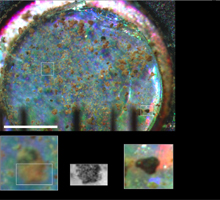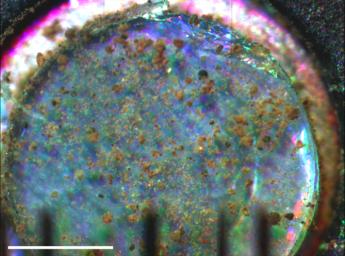
Click on image for larger version of Figure 1This image taken by the Optical Microscope on NASA's Phoenix Mars Lander shows soil sprinkled from the lander's Robot Arm scoop onto a silicone substrate. The substrate was then rotated in front of the microscope. This is the first sample collected and delivered for instrumental analysis onboard a planetary lander since NASA's Viking Mars missions of the 1970s. It is also the highest resolution image yet seen of Martian soil.
The image is dominated by fine particles close to the resolution of the microscope. These particles have formed clumps, which may be a smaller scale version of what has been observed by Phoenix during digging of the surface material.
The microscope took this image during Phoenix's Sol 17 (June 11), or the 17th Martian day after landing. The scale bar is 1 millimeter (0.04 inch).
Zooming in on the Martian Soil
In figure 1, three zoomed-in portions are shown with an image of Martian soil particles taken by the Optical Microscope on NASA's Phoenix Mars Lander.
The left zoom box shows a composite particle. The top of the particle has a green tinge, possibly indicating olivine. The bottom of the particle has been reimaged at a different focus position in black and white (middle zoom box), showing that this is a clump of finer particles.
The right zoom box shows a rounded, glassy particle, similar to those which have also been seen in an earlier sample of airfall dust collected on a surface exposed during landing.
The shadows at the bottom of image are of the beams of the Atomic Force Microscope.
The Phoenix Mission is led by the University of Arizona, Tucson, on behalf of NASA. Project management of the mission is by NASA’s Jet Propulsion Laboratory, Pasadena, Calif. Spacecraft development is by Lockheed Martin Space Systems, Denver.
Photojournal Note: As planned, the Phoenix lander, which landed May 25, 2008 23:53 UTC, ended communications in November 2008, about six months after landing, when its solar panels ceased operating in the dark Martian winter.

 Planetary Data System
Planetary Data System













